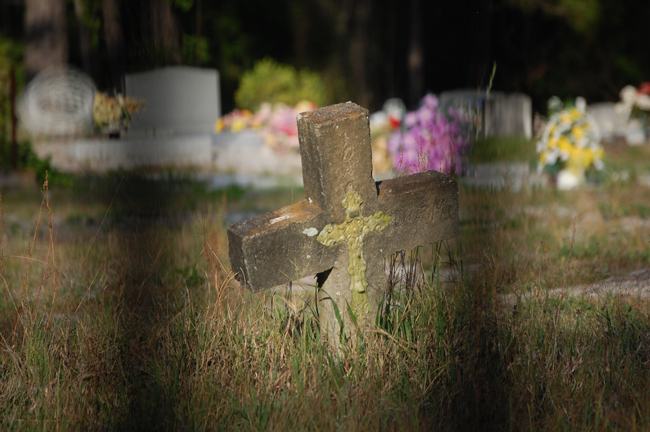
For 62 years, the Masonic cemetery off Old King’s Road has been a refuge for Flagler County’s black families whose dead were either denied a proper burial closer to home or whose graves were smashed up and entombed by white-owned homes. A white landowner had provided the five-acre consolation grounds miles from Bunnell in 1948, cloaking bigotry in forbearance: Blacks were forced to make the miles-long trek to the east end of the county to bury their dead, and the dead were well out of sight.
The cemetery, where close to 540 graves have been identified, remains a place where poorer blacks can bury their own for about $350, compared to the $5,000 or so required at ritzier cemeteries. It is also the closest thing Palm Coast has to a monument, pre-dating the town’s existence by a few decades and adjoining a portion of the original Old Kings Road, built by England during the revolutionary wars as the first main highway into the wilds of Florida.
Click On: |
Today, the Masonic cemetery is being “re-dedicated” by Palm Coast after two years of restoration and re-routing to accommodate the widening to four lanes of the new Old Kings Road (itself re-routed to accommodate a Walmart store on a property that will bury other old portions of the original Old Kings Road). The city council held a brief ceremony there before its morning meeting, both to spotlight the work at the cemetery and have an official look at the re-opened Old Kings Road.
The cemetery’s entrance has been moved slightly south. Plans for coquina pillars and a wrought-iron entrance didn’t come to pass, but the city still hopes to build those with a grant in the future. The cemetery’s surrounding grounds have been handsomely landscaped and replanted with native plants, and a black iron fence has been placed around the cemetery grounds.
The fence “really served to make it look like a cemetery again,” said Bill Butler, Palm Coast’s landscape architect, when he summed up the restoration to the city council in May.
“Also created a definition,” Jim Landon said of the fence. “There was always a question of where it started and stopped.” The fence, in other words, will prevent the cemetery from growing beyond its boundaries.
In the future Butler said, “maybe one of our service groups, Rotary or something, can build us a kiosk, we’re working with Dana St. Clair, the archeologist, and we’ve got a lot of historical information that I think is important to this cemetery that the public needs to know, and we’ll identify this as one of the few preserved sections of King’s Road that still exists.”
The restoration was not funded as a separate project, but as part of the widening of the highway. “We needed support of all the property owners along there,” Landon said. “Most of them were private or vacant developers on the property. But this was one where we were just trying to be good neighbors, and the district people, property owners agreed that this would be a nice thing to kind of beef this up, beautify it a little bit so it was more of an asset than an eyesore.”
In its original plans, Palm Coast tried to take over the cemetery outright. That reopened old wounds. The city, an administrative report to the council stated in 2008, “held several meetings with the Espanola Masonic Lodge and Reverend Frank Giddens to discuss the project and the city’s desire to work with the lodge to restore the cemetery. Initially, the discussion focused on city ownership and maintenance of the cemetery. However, the members of the lodge expressed a strong desire to retain ownership but enter into a partnership with the city.” There’s still a lack of clarity over who is responsible for maintaining the place.
Palm Coast, in an agreement the city council subsequently approved in 2008, recognized “that maintaining the cemetery is an important function that will provide economic health, safety and welfare benefits to the citizens of the city, and that this agreement has a public purpose which outweighs any private benefit.” The agreement also agreed to “undertake the restoration, repair and maintenance of the cemetery.”
Maintenance, however, does not appear to be part of the city’s plans from here on. “It’s still a private cemetery,” City Manager Jim Landon said. “We’ve done what we’re going to do kind of approach, and then the Masonic Lodge is still responsible for the Masonic Cemetery and it’s still their responsibility to operate it and maintain it.”
The resolution the city approved in 2008 specified that the Espanola Masonic Lodge’s would be responsible for daily operation of the cemetery, which it defined as coordinating burial services, maintaining burial records and providing for the supervision and monitoring of the cemetery. But those responsibility were separate from those of the city, which were also defined as “restoration, maintenance and repair.”





























Leave a Reply